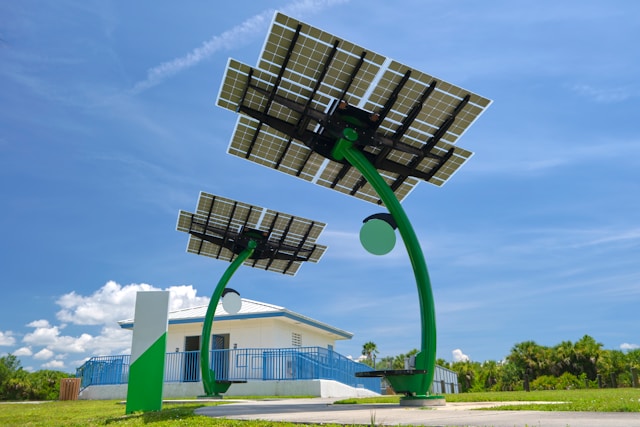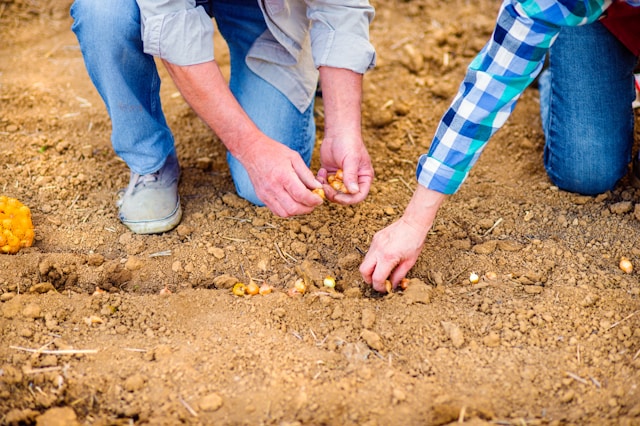Hey everyone!
Have you ever thought about combining your love for the environment with your desire to volunteer? If so, you’re in luck because the green tech sector is booming with opportunities for enthusiastic volunteers like us. Whether you’re a tech wizard, a budding engineer, or someone who just wants to make a difference, there’s a spot for you in this exciting field. Let’s dive into some of the coolest volunteer opportunities out there right now.

1. Community Solar Projects
Community solar projects are an amazing way to make renewable energy accessible to everyone, even if you don’t have the ideal setup for solar panels at home. These projects work by setting up shared solar arrays—large groups of solar panels that generate electricity for multiple households or businesses within a community. The idea is simple: pool resources to build a larger solar installation that benefits more people.
How It Works
Community solar projects generally operate on a subscription basis. Participants can buy or lease a portion of the solar array, and in return, they receive credits on their electricity bills based on the amount of power their portion generates. This makes solar power accessible to renters, those with shaded roofs, and anyone who might not be able to afford the upfront cost of installing solar panels on their own.
Volunteer Roles
Volunteering for community solar projects can be incredibly diverse and fulfilling. Here are some of the roles you might find yourself in:
-
Outreach and Education: Help spread the word about the benefits of community solar. This can involve organizing community meetings, creating informational materials, or even going door-to-door to talk to neighbors.
-
Administrative Support: Assist with the behind-the-scenes work, such as managing subscriptions, processing payments, and handling customer inquiries.
-
Installation Assistance: Get hands-on experience by helping with the physical installation of solar panels. This can involve tasks like setting up mounting systems, wiring, and panel placement. Don’t worry if you’re not an expert—there’s plenty of on-the-job training provided.
-
Maintenance and Monitoring: Once the panels are up and running, volunteers can help with regular maintenance checks and performance monitoring to ensure everything is operating smoothly.
Benefits of Volunteering
Volunteering for community solar projects offers numerous benefits. For starters, you’ll be directly contributing to the expansion of renewable energy, reducing reliance on fossil fuels, and lowering carbon emissions. It’s also a fantastic way to meet people who share your passion for sustainability and green technology.
Additionally, you’ll gain valuable skills and experience that can be a stepping stone to a career in the renewable energy sector. Whether you’re interested in technical installation, customer service, or project management, there’s something for everyone.
Getting Started
Ready to get involved? Here are a few steps to kickstart your journey:
-
Research Local Projects: Look for community solar projects in your area. Websites like Solar United Neighbors and Community Solar Hub are great places to start.
-
Reach Out: Contact the project organizers to express your interest in volunteering. They can provide you with more information on current opportunities and how you can get involved.
-
Attend Training Sessions: Many projects offer training sessions for new volunteers. These sessions will equip you with the knowledge and skills needed to effectively contribute to the project.
-
Get Involved: Jump in and start volunteering! Whether you’re helping with outreach, installation, or maintenance, your efforts will make a significant impact.
Community solar projects are a win-win for everyone involved. They provide clean, renewable energy to those who might not otherwise have access, and they offer a fulfilling way for volunteers to contribute to a greener future. So, why not join in and help power your community with the sun?
If you know of any other community solar initiatives or have experiences to share, drop a comment below! Let’s keep the conversation going and support each other in making a difference.

2. Urban Farming and Sustainable Agriculture
Urban farming and sustainable agriculture are transforming cities into greener, more sustainable spaces. These initiatives bring farming practices into urban settings, promoting local food production, reducing food miles, and fostering community engagement. If you’re passionate about gardening, sustainability, or just getting your hands dirty, volunteering in urban farming might be the perfect fit for you.
What is Urban Farming?
Urban farming involves growing food in city environments, utilizing rooftops, vacant lots, community gardens, and even vertical spaces. It’s all about making the most of the available space to produce fresh, local food. Sustainable agriculture, on the other hand, focuses on farming methods that are environmentally friendly, economically viable, and socially responsible. Combining these two concepts, urban farming emphasizes sustainability, innovation, and community.
Volunteer Roles
There are numerous ways to get involved in urban farming and sustainable agriculture. Here are some of the roles you might find yourself in:
-
Planting and Harvesting: This is the heart of urban farming. Volunteers help plant seeds, care for growing plants, and harvest the produce when it’s ready. It’s a great way to learn about different crops and the growing process.
-
Composting and Soil Management: Healthy soil is crucial for successful farming. Volunteers can help manage compost systems, which recycle organic waste into nutrient-rich soil. This is a key aspect of sustainable agriculture.
-
Educational Outreach: Many urban farms offer educational programs to teach the community about sustainable farming practices. Volunteers might lead workshops, give tours, or create educational materials.
-
Farm Maintenance: Keeping the farm running smoothly requires regular maintenance. Volunteers can assist with tasks like weeding, watering, building raised beds, and maintaining equipment.
-
Marketing and Sales: Urban farms often sell their produce at local markets or through community-supported agriculture (CSA) programs. Volunteers can help with packaging, sales, and promoting the farm’s products.
Benefits of Volunteering
Volunteering in urban farming and sustainable agriculture has numerous benefits. You’ll gain hands-on experience in farming techniques and sustainable practices, which is not only educational but also incredibly rewarding. Working on an urban farm can also be a fantastic way to meet new people and become part of a community dedicated to sustainability.
Moreover, you’ll be contributing to local food systems, which helps reduce reliance on long-distance transportation and promotes food security. The produce grown on urban farms is often fresher and healthier, providing communities with access to nutritious food.
Getting Started
If you’re excited about the idea of urban farming and want to get involved, here’s how you can start:
-
Find Local Projects: Look for urban farming projects or community gardens in your area. Websites like Green City Growers and The Urban Farm can help you find opportunities nearby.
-
Reach Out: Contact the organizers of these projects to express your interest in volunteering. They can provide you with information on current needs and how you can help.
-
Attend an Orientation: Many urban farms offer orientation sessions for new volunteers. These sessions will introduce you to the farm, its goals, and the various tasks you’ll be involved in.
-
Start Volunteering: Dive in and start contributing! Whether you’re planting seeds, managing compost, or educating the community, your efforts will make a real difference.
Urban farming and sustainable agriculture offer unique opportunities to connect with nature, support local food systems, and promote environmental sustainability within urban environments. By volunteering, you’ll be playing a part in creating greener, healthier cities. So, why not join an urban farming project and start making a difference today?
If you have any favorite urban farms or experiences to share, let us know in the comments below. Let’s continue to support each other in building sustainable urban communities!

3. E-Waste Recycling Programs
E-waste, or electronic waste, refers to discarded electronic devices such as smartphones, computers, televisions, and other gadgets. With the rapid pace of technological advancement, e-waste is one of the fastest-growing waste streams in the world. Properly recycling e-waste is crucial for environmental and public health, as these items often contain hazardous materials. Volunteering in e-waste recycling programs is a fantastic way to help manage this growing problem and contribute to a more sustainable future.
Why E-Waste Recycling Matters
E-waste contains valuable materials like gold, silver, copper, and rare earth elements that can be recovered and reused. However, it also contains toxic substances like lead, mercury, and cadmium, which can pose serious environmental and health risks if not handled properly. Recycling e-waste helps to:
- Reduce Pollution: Proper recycling prevents harmful chemicals from leaching into the soil and water.
- Conserve Resources: Recovering precious metals from e-waste reduces the need for mining and conserves natural resources.
- Support Economic Development: The recycling industry creates jobs and promotes sustainable economic growth.
- Reduce Greenhouse Gas Emissions: Recycling electronics reduces the energy consumption associated with manufacturing new products.
Volunteer Roles
Volunteering in e-waste recycling programs can involve a variety of tasks, depending on your interests and skills. Here are some common roles:
-
Collection Drives: Help organize and run e-waste collection events in your community. This can involve setting up collection points, promoting the event, and assisting people who bring in their old electronics.
-
Sorting and Disassembly: At recycling facilities, volunteers can assist with sorting different types of e-waste and disassembling devices to separate recyclable components. This is a great way to learn more about the inner workings of electronics.
-
Data Management: Properly managing and tracking e-waste is crucial for efficient recycling. Volunteers can help with data entry, inventory management, and ensuring that items are processed correctly.
-
Public Education and Outreach: Educating the public about the importance of e-waste recycling is key to increasing participation. Volunteers can create educational materials, give presentations, and engage with the community to raise awareness.
-
Technical Assistance: For those with a background in electronics or IT, providing technical assistance at recycling centers can be incredibly valuable. This might involve troubleshooting equipment, repairing devices for reuse, or helping to improve recycling processes.
Benefits of Volunteering
Volunteering in e-waste recycling programs offers numerous benefits. You’ll be directly contributing to reducing environmental pollution and conserving valuable resources. Additionally, you’ll gain insights into the lifecycle of electronic products and the complexities of recycling them.
Volunteering can also be a stepping stone to a career in environmental science, waste management, or sustainability. It provides practical experience and networking opportunities with professionals in the field. Plus, it’s a great way to meet like-minded individuals who share your commitment to environmental protection.
Getting Started
Interested in getting involved? Here’s how you can start:
-
Research Local Programs: Look for e-waste recycling programs and events in your area. Websites like e-Stewards and Earth911 can help you find local opportunities.
-
Contact Organizations: Reach out to recycling centers, environmental groups, or community organizations that run e-waste programs. Let them know you’re interested in volunteering and ask about available opportunities.
-
Attend Training Sessions: Many organizations offer training for new volunteers. These sessions will teach you about proper e-waste handling, safety procedures, and the specifics of their recycling process.
-
Start Volunteering: Once you’re trained, dive in and start making a difference. Whether you’re helping with collection, sorting, or education, your efforts will be invaluable.
Making a Difference
E-waste recycling is a critical part of managing our modern waste streams and protecting the environment. By volunteering, you’ll be playing a crucial role in this effort. So, why not get involved and help ensure that our electronic devices are disposed of responsibly?
Have you participated in e-waste recycling programs before? Share your experiences and tips in the comments below. Together, we can make a significant impact!

4. Green Building Initiatives
Green building initiatives are at the forefront of creating a sustainable future by designing and constructing buildings that are environmentally responsible and resource-efficient. These initiatives focus on reducing the environmental impact of buildings through sustainable design, construction, operation, and maintenance. Volunteering in green building projects offers a unique opportunity to contribute to the creation of healthier, more sustainable living and working environments.
What Are Green Building Initiatives?
Green building initiatives encompass a wide range of practices aimed at improving the environmental performance of buildings. This includes using sustainable materials, enhancing energy efficiency, reducing water consumption, and ensuring good indoor air quality. The ultimate goal is to create structures that have a minimal environmental footprint throughout their lifecycle—from design and construction to operation and demolition.
Volunteer Roles
Volunteering in green building initiatives can involve a variety of tasks, depending on your skills and interests. Here are some common roles:
-
Construction and Renovation: Get hands-on experience by helping with the construction or renovation of green buildings. This can include tasks like installing energy-efficient windows, setting up rainwater harvesting systems, or using sustainable materials in building projects.
-
Energy Audits: Assist in conducting energy audits for buildings. This involves assessing the building’s energy use and identifying areas where improvements can be made to enhance energy efficiency.
-
Community Outreach and Education: Educate the community about the benefits of green building practices. Volunteers can help organize workshops, create educational materials, and give presentations to raise awareness about sustainable building techniques.
-
Design Assistance: For those with a background in architecture or design, volunteering can involve helping with the design of green buildings. This might include drafting plans, selecting sustainable materials, or developing energy-efficient layouts.
-
Maintenance and Landscaping: Once a green building is constructed, ongoing maintenance is crucial. Volunteers can help with tasks like maintaining green roofs, managing rain gardens, or ensuring that renewable energy systems are functioning properly.
Benefits of Volunteering
Volunteering in green building initiatives offers numerous benefits. You’ll gain practical experience in sustainable construction techniques and learn about the latest innovations in green building. This hands-on experience can be incredibly valuable for anyone interested in a career in architecture, construction, or environmental science.
Additionally, you’ll be contributing to the creation of healthier, more sustainable living environments. Green buildings often have improved air quality, better natural lighting, and reduced utility costs, which can significantly enhance the quality of life for occupants.
Getting Started
If you’re excited about the idea of contributing to green building initiatives, here’s how you can start:
-
Find Local Projects: Look for green building projects or organizations in your area. Websites like US Green Building Council and Habitat for Humanity often have information on ongoing projects and volunteer opportunities.
-
Reach Out: Contact the organizations running these projects to express your interest in volunteering. They can provide you with details on current needs and how you can get involved.
-
Attend Training Sessions: Many green building projects offer training for new volunteers. These sessions will teach you about sustainable building practices, safety procedures, and specific tasks you’ll be performing.
-
Start Volunteering: Once you’re trained, dive in and start contributing. Whether you’re helping with construction, conducting energy audits, or educating the community, your efforts will be making a significant impact.
Making a Difference
Green building initiatives are crucial for creating a sustainable future. By volunteering, you’ll be playing a key role in reducing the environmental impact of buildings and promoting sustainable living. Plus, you’ll gain valuable skills and experience that can benefit you in many ways.
So, why not get involved in a green building project and start making a difference today? If you have any experiences or tips to share about volunteering in green building initiatives, let us know in the comments below. Together, we can build a more sustainable world!
5. Environmental Education and Outreach
Environmental education and outreach are vital components of the effort to promote sustainability and environmental stewardship. These initiatives aim to raise awareness about environmental issues and inspire individuals and communities to adopt more sustainable practices. Volunteering in environmental education and outreach allows you to share your passion for the environment with others and help create a more informed and engaged public.
What is Environmental Education and Outreach?
Environmental education involves teaching people about the natural world and how human activities impact it. This can include topics like climate change, conservation, recycling, and renewable energy. Outreach efforts aim to spread this knowledge to a wider audience through community events, workshops, school programs, and media campaigns. The goal is to empower people with the information they need to make environmentally conscious decisions.
Volunteer Roles
There are numerous ways to get involved in environmental education and outreach. Here are some common roles you might find yourself in:
-
Teaching and Presentations: Volunteers can lead educational sessions in schools, community centers, or online. This might involve giving presentations on specific environmental topics, leading hands-on activities, or facilitating discussions.
-
Creating Educational Materials: Help develop resources like pamphlets, posters, videos, and online content that explain environmental issues and solutions. These materials can be used in schools, community programs, or social media campaigns.
-
Event Planning and Coordination: Organize and run events such as eco-fairs, clean-up drives, tree planting activities, or workshops. Volunteers can help with everything from planning and promotion to setting up and running the events.
-
Community Outreach: Engage with the public through various outreach activities. This might include setting up information booths at local events, conducting door-to-door outreach, or running social media campaigns to spread awareness about environmental issues.
-
Advocacy and Campaigning: Support efforts to advocate for environmental policies and practices. This can involve writing letters to policymakers, organizing petitions, or participating in campaigns to promote sustainable policies.
Benefits of Volunteering
Volunteering in environmental education and outreach offers numerous benefits. You’ll have the opportunity to make a tangible impact by educating others about important environmental issues. This can lead to increased community awareness and action, ultimately contributing to broader environmental sustainability efforts.
Additionally, you’ll develop valuable skills such as public speaking, event planning, and educational content creation. These experiences can be particularly beneficial for those interested in careers in education, environmental science, or public policy. Plus, volunteering in this field is a great way to meet like-minded individuals who share your passion for the environment.
Getting Started
Interested in getting involved in environmental education and outreach? Here’s how you can start:
-
Research Organizations: Look for organizations that focus on environmental education and outreach in your area. Websites like The Sierra Club and Earth Day Network are good starting points.
-
Contact Local Groups: Reach out to schools, community centers, and environmental organizations to inquire about volunteer opportunities. Many of these groups are often looking for enthusiastic volunteers to help with their programs.
-
Attend Training Sessions: Many organizations offer training for new volunteers. These sessions will provide you with the knowledge and skills needed to effectively educate and engage the public on environmental issues.
-
Start Volunteering: Dive in and start making a difference. Whether you’re teaching a class, creating educational materials, or organizing an event, your efforts will be helping to spread awareness and promote sustainable practices.
Making a Difference
Environmental education and outreach are crucial for fostering a culture of sustainability and environmental stewardship. By volunteering, you’ll be helping to educate and inspire others to take action for the environment. It’s a fulfilling way to contribute to the community and help build a more sustainable future.
So, why not join an environmental education or outreach program and start making a difference today? If you have any experiences or tips to share about volunteering in this field, let us know in the comments below. Together, we can educate and inspire others to protect our planet!
6. Clean Energy Advocacy
Clean energy advocacy is a powerful way to promote the adoption of renewable energy sources and reduce our reliance on fossil fuels. As the world faces the pressing challenges of climate change and environmental degradation, advocating for clean energy policies and practices is more important than ever. Volunteering in clean energy advocacy allows you to be at the forefront of the movement for a sustainable and greener future.
What is Clean Energy Advocacy?
Clean energy advocacy involves promoting the use of renewable energy sources such as solar, wind, hydro, and geothermal. This advocacy can take many forms, including lobbying for policy changes, raising public awareness, and supporting the development of clean energy projects. The goal is to drive the transition from fossil fuels to cleaner, more sustainable energy sources that reduce greenhouse gas emissions and environmental impacts.
Volunteer Roles
There are numerous ways to get involved in clean energy advocacy. Here are some common roles you might find yourself in:
-
Policy Advocacy: Work with organizations to advocate for clean energy policies at the local, state, and national levels. This can involve researching policy issues, meeting with legislators, writing letters, and participating in campaigns to support renewable energy legislation.
-
Public Education: Raise awareness about the benefits of clean energy and the importance of transitioning away from fossil fuels. Volunteers can give presentations, create educational materials, and engage with the community through events and social media.
-
Grassroots Organizing: Mobilize community members to support clean energy initiatives. This can involve organizing rallies, petition drives, phone banks, and canvassing to build support for clean energy policies and projects.
-
Research and Analysis: Assist with researching and analyzing data related to clean energy technologies, policies, and market trends. This information can be used to inform advocacy efforts and educate policymakers and the public.
-
Communications and Media: Help spread the word about clean energy issues through various media channels. Volunteers can write articles, manage social media accounts, create videos, and work with the press to promote clean energy initiatives.
Benefits of Volunteering
Volunteering in clean energy advocacy offers numerous benefits. You’ll be directly contributing to the fight against climate change and helping to build a sustainable energy future. This work can be incredibly fulfilling, as you’ll see the tangible impact of your efforts in policy changes, increased public awareness, and the growth of renewable energy projects.
Additionally, you’ll develop valuable skills such as policy analysis, public speaking, community organizing, and media communications. These experiences can be particularly beneficial for those interested in careers in environmental policy, advocacy, or communications. Plus, you’ll have the opportunity to work alongside passionate individuals who share your commitment to clean energy.
Getting Started
If you’re excited about the idea of advocating for clean energy, here’s how you can start:
-
Research Organizations: Look for organizations that focus on clean energy advocacy. Websites like 350.org, Sierra Club, and Environmental Defense Fund are good places to start.
-
Contact Advocacy Groups: Reach out to these organizations to inquire about volunteer opportunities. Many groups are looking for dedicated volunteers to support their advocacy efforts.
-
Attend Training Sessions: Many organizations offer training for new volunteers. These sessions will provide you with the knowledge and skills needed to effectively advocate for clean energy policies and practices.
-
Start Volunteering: Dive in and start making a difference. Whether you’re meeting with policymakers, educating the public, or organizing community events, your efforts will help drive the transition to clean energy.
Making a Difference
Clean energy advocacy is a critical part of the effort to combat climate change and build a sustainable future. By volunteering, you’ll be playing a key role in promoting renewable energy and reducing our dependence on fossil fuels. It’s a rewarding way to contribute to the global movement for a greener planet.
So, why not get involved in clean energy advocacy and start making a difference today? If you have any experiences or tips to share about volunteering in this field, let us know in the comments below. Together, we can advocate for a clean, sustainable energy future!

7. Wildlife Conservation Tech
Wildlife conservation tech is an exciting and rapidly growing field that leverages cutting-edge technology to protect and preserve wildlife. As human activities increasingly impact natural habitats and threaten species, innovative technological solutions are becoming essential tools in the conservationist’s arsenal. Volunteering in wildlife conservation tech offers a unique opportunity to blend your love for nature with a passion for technology, making a tangible difference in the fight to protect endangered species and ecosystems.
What is Wildlife Conservation Tech?
Wildlife conservation tech involves using technology to monitor, study, and protect wildlife and their habitats. This can include a range of tools and methods such as drones, GPS tracking, camera traps, remote sensing, and data analytics. These technologies help conservationists gather critical information, track animal movements, prevent poaching, and manage conservation efforts more effectively.
Volunteer Roles
There are numerous ways to get involved in wildlife conservation tech, catering to a variety of skills and interests. Here are some common roles you might find yourself in:
-
Drone Operation and Monitoring: Drones are increasingly used in conservation to survey large areas, monitor wildlife populations, and detect illegal activities such as poaching. Volunteers can assist with piloting drones, analyzing aerial footage, and maintaining equipment.
-
GPS Tracking and Data Collection: Help with tracking wildlife by attaching and monitoring GPS collars on animals. This data is crucial for understanding migration patterns, habitat use, and threats. Volunteers can assist in setting up tracking devices, collecting data, and analyzing movement patterns.
-
Camera Traps and Remote Sensing: Camera traps and remote sensors are used to capture images and videos of wildlife in their natural habitats. Volunteers can help set up and maintain these devices, as well as analyze the data collected to identify species, behaviors, and population trends.
-
Data Analysis and Management: The vast amount of data generated by conservation technologies requires careful management and analysis. Volunteers with skills in data science, GIS (Geographic Information Systems), or programming can contribute by processing and interpreting this data to inform conservation strategies.
-
Community Engagement and Education: Technology alone isn’t enough to save wildlife—community involvement is crucial. Volunteers can help educate local communities about the importance of wildlife conservation and how they can use technology to protect their natural resources.
Benefits of Volunteering
Volunteering in wildlife conservation tech offers numerous benefits. You’ll gain hands-on experience with cutting-edge technologies and learn about their applications in real-world conservation efforts. This can be incredibly rewarding and educational, especially if you’re interested in a career in conservation biology, environmental science, or technology.
Additionally, you’ll be contributing to critical conservation work that helps protect endangered species and preserve biodiversity. Your efforts can lead to significant improvements in wildlife management and protection, making a real difference in the survival of species and the health of ecosystems.
Getting Started
If you’re excited about the idea of volunteering in wildlife conservation tech, here’s how you can start:
-
Research Organizations: Look for organizations that focus on wildlife conservation and use technology in their efforts. Websites like Wildlife Conservation Society, World Wildlife Fund, and Conservation International are great places to start.
-
Contact Conservation Groups: Reach out to these organizations to inquire about volunteer opportunities. Many groups are looking for enthusiastic volunteers to support their tech-based conservation projects.
-
Attend Training Sessions: Many conservation organizations offer training for new volunteers. These sessions will teach you how to use the various technologies and methods employed in wildlife conservation.
-
Start Volunteering: Once you’re trained, dive in and start contributing. Whether you’re flying drones, setting up camera traps, or analyzing data, your efforts will be invaluable to conservation projects.
Making a Difference
Wildlife conservation tech is a vital part of modern conservation efforts, providing the tools needed to monitor and protect wildlife in ways that were previously impossible. By volunteering, you’ll be playing a key role in these innovative efforts, helping to safeguard the planet’s biodiversity for future generations.
So, why not get involved in wildlife conservation tech and start making a difference today? If you have any experiences or tips to share about volunteering in this field, let us know in the comments below. Together, we can harness the power of technology to protect our planet’s precious wildlife!
Get Started Today
Ready to dive in? Start by researching local organizations and projects that interest you. Reach out to see how you can get involved. Remember, every little bit helps, and your contribution can make a significant difference.
Let’s harness our passion for technology and the environment to create a greener, more sustainable future. Happy volunteering!
Got any other cool green tech volunteer opportunities? Share them with us in the comments below!




